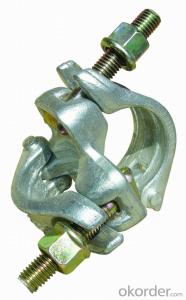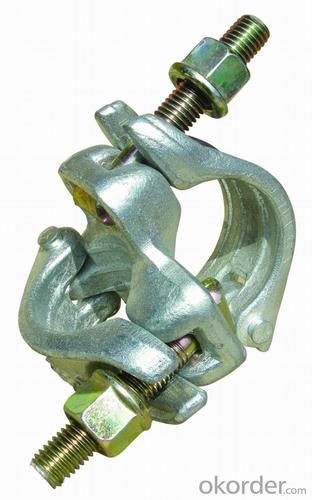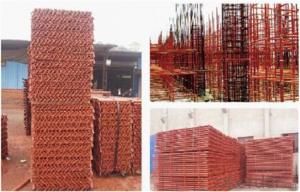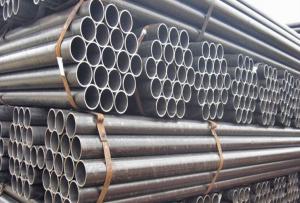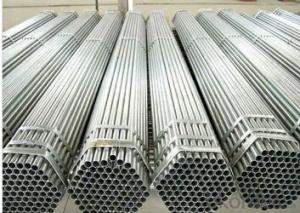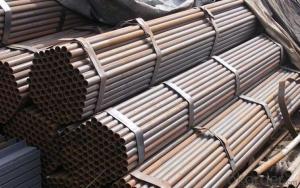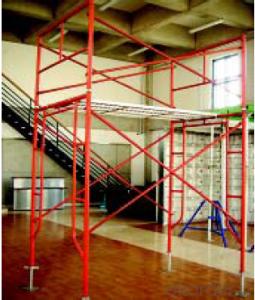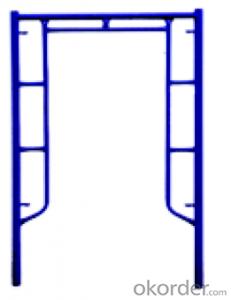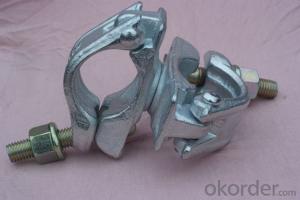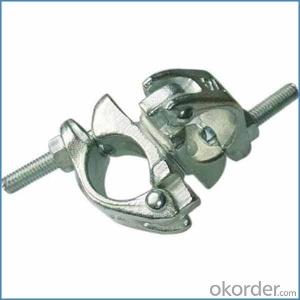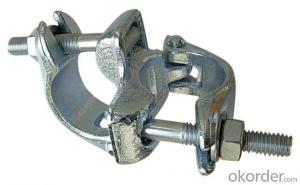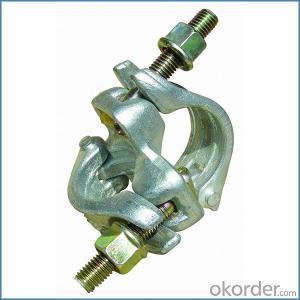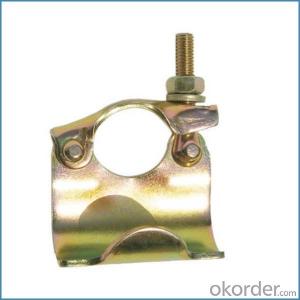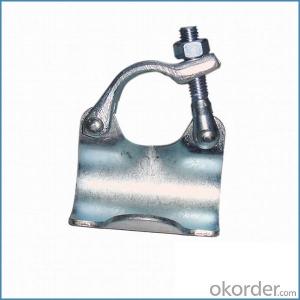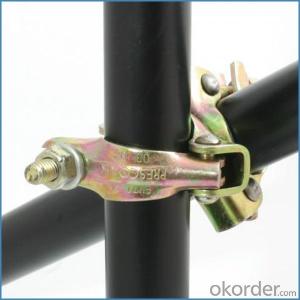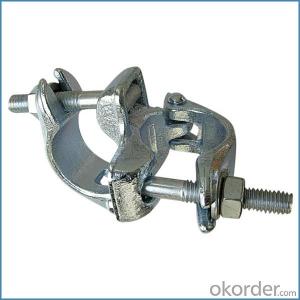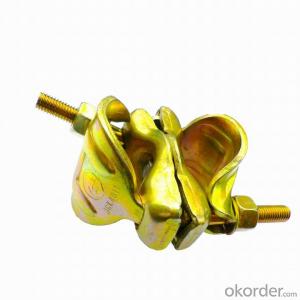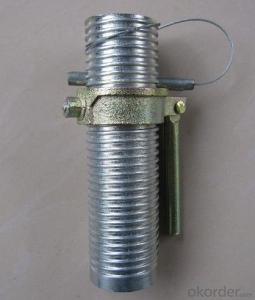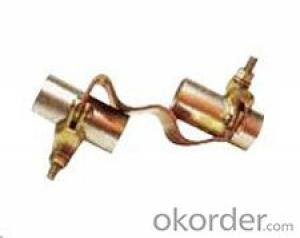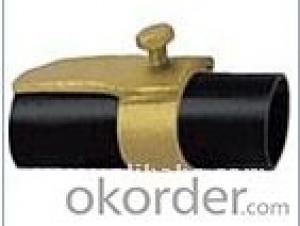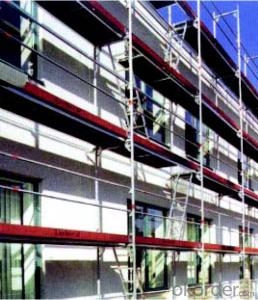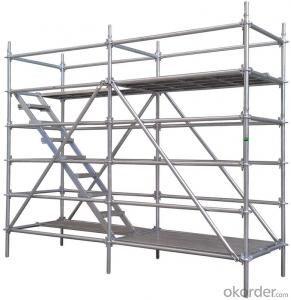Aluminium Scaffold Clamp Britis German Forged Type
- Loading Port:
- Tianjin
- Payment Terms:
- TT OR LC
- Min Order Qty:
- 1000 kg
- Supply Capability:
- 100000 kg/month
OKorder Service Pledge
OKorder Financial Service
You Might Also Like
Aluminium Scaffold Clamp Britis German Forged Type
Description
1.The scaffolding coupler is always used to connect the steel pipe as scaffolding system.
2.The often used coupler is swivel coupler and righ angle coupler .
3.We can provide types of scaffolding coupler according to your requirement.
4.Couoler can fix the 48.3mm scaffolding steel pipe tightly and make the whole scaffolding system more steadily.
Feature
(1)Excellent Anti-Breaking—Cold Pressed Steel
(2)Outstanding Resistance Deformation
(3)Strong Anti-Dropping Ability
Photo
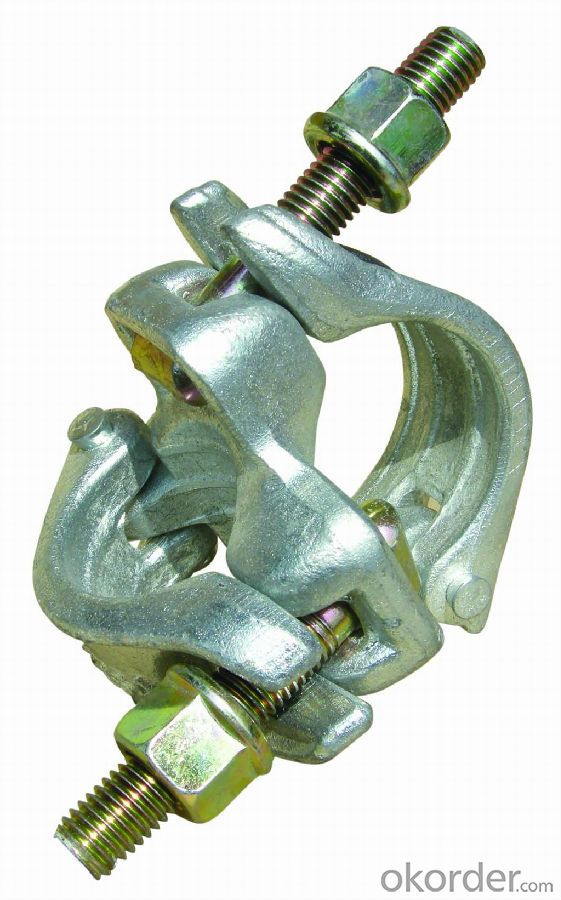
Parameter
| Material | Q235,345steel |
| Size | 48.3mm*48.3mm |
| Surface finish | Galvanized |
| Weight | 1.1kg around |
| Standard | BS1139,EN74 |
| Package | 25pcs/bag,steel pallet |
| Manufacture | As per customer requirement |
| Market | Africa, South America, the Middle East and Asia |
FAQ
Q: Are you a factory or trading company?
We are a state-owned corporation in China,dealing with various kinds of building materials.We have our holding subsidiaries.
Q: Where is your factory located? How can I visit there?
Our factory is located all around China.
Q: Can I get some samples?
Sample is free, customer only pay freight for the first time.
Q: Delivery?
10-30days. (5-15 containers)
Any question,feel free to contact us.
- Q: How do steel tube couplers attach to scaffolding tubes?
- Scaffolding tubes are connected using steel tube couplers, which are slid onto the end of the tube and secured in place with a tightening mechanism. The coupler consists of a sleeve and a wedge. The sleeve is a hollow cylindrical metal component that fits tightly over the tube, while the wedge is a wedge-shaped piece inserted into the sleeve. To attach the coupler, first, place the sleeve onto the tube, ensuring proper positioning and alignment. Then, insert the wedge into the sleeve with the angled side facing towards the tube. Push the wedge into the sleeve, creating a strong grip on the tube and effectively locking the coupler. Once attached, the coupler provides a secure connection between two scaffolding tubes, allowing them to be joined to form the desired structure. The tight grip ensures stability and strength, enabling the scaffolding to safely support the weight of workers and materials. It's crucial to note that trained and experienced scaffolders should handle the installation of steel tube couplers. They should have a thorough understanding of correct procedures and safety regulations. Proper installation and regular inspections are essential to maintain the integrity of the scaffolding structure and prevent accidents or failures.
- Q: Can steel tube couplers be used in confined spaces or narrow scaffolding structures?
- Steel tube couplers have the ability to be utilized in confined spaces or narrow scaffolding structures. These couplers serve as a type of fitting that connects multiple steel tubes together. Typically employed in construction and scaffolding applications, they create a secure and stable structure. One of the key advantages of employing steel tube couplers lies in their versatility and adaptability. They can be arranged in various configurations and easily adjusted or repositioned to meet different requirements. Consequently, they are well-suited for use in confined spaces or narrow scaffolding structures where there may be limited working space. Furthermore, steel tube couplers are specifically designed to establish a strong and reliable connection between steel tubes. Manufactured from high-quality steel, they are constructed to endure heavy loads and harsh conditions. This guarantees the safety and stability of the scaffolding structure, even within confined or narrow spaces. However, it is crucial to acknowledge that when working in confined spaces or narrow scaffolding structures, it is imperative to take proper safety precautions. This includes ensuring that the scaffolding is correctly erected, utilizing appropriate fall protection equipment, and adhering to all relevant safety guidelines and regulations.
- Q: What are the common troubleshooting tips for any issues with steel tube couplers in scaffolding?
- To troubleshoot problems with steel tube couplers in scaffolding, there are several helpful tips that can be used to identify and resolve the issue: 1. Begin by conducting a thorough inspection of the couplers to check for any visible signs of damage or wear. Look for cracks, bends, or deformities in the coupler body, as well as signs of corrosion. If any problems are found, replace the affected coupler immediately. 2. Ensure that the couplers are installed and tightened correctly, following the guidelines provided by the manufacturer. Incorrect installation can lead to loose connections or weak joints, compromising the stability and safety of the scaffolding structure. 3. Confirm that the couplers being used are compatible with the steel tubes being connected. Different couplers are designed for specific tube sizes and types, and using an incompatible coupler can result in a weak or unstable connection. 4. Keep the couplers clean and free from dirt, debris, or any foreign objects. These can obstruct the proper engagement and tightening of the coupler, resulting in issues with the scaffolding structure. 5. Implement a regular maintenance schedule to inspect and maintain the scaffolding system. This includes checking the couplers for signs of wear, lubricating moving parts if necessary, and tightening connections that may have loosened over time. 6. Ensure that the scaffolding system is not overloaded beyond its recommended capacity. Excessive weight or stress can cause the couplers to fail, leading to potential accidents or collapse. 7. If the problem persists or is beyond your expertise, it is advisable to seek professional assistance from a qualified scaffolding engineer or technician. They can provide a more thorough inspection, identify any underlying issues, and recommend appropriate solutions. By following these troubleshooting tips, you can address common issues with steel tube couplers in scaffolding and maintain a safe and reliable working environment.
- Q: Are steel tube couplers compatible with scaffolding edge protection systems?
- Yes, steel tube couplers are compatible with scaffolding edge protection systems. Steel tube couplers are commonly used in scaffolding to connect scaffold tubes together, providing stability and strength to the scaffolding structure. These couplers are designed to securely fasten the tubes, ensuring the safety of the scaffold and the workers on it. When it comes to edge protection systems, steel tube couplers can be used to attach various components of the system, such as guardrails, toe boards, and mesh panels, to the scaffold. The couplers allow for easy installation and adjustment of the edge protection system, ensuring that it is securely attached to the scaffold and providing adequate protection to workers from falling off the edges. It is important to note that the compatibility of steel tube couplers with scaffolding edge protection systems may vary depending on the specific design and requirements of the system. Therefore, it is recommended to consult with a qualified scaffolding engineer or supplier to ensure that the steel tube couplers being used are compatible with the specific edge protection system being installed.
- Q: Can steel tube couplers be used in scaffolding structures with uneven or sloped surfaces?
- Scaffolding structures with uneven or sloped surfaces can indeed utilize steel tube couplers. These couplers possess great versatility, as they can be adapted to various angles and surfaces. By establishing a secure and stable connection between scaffolding tubes, steel tube couplers guarantee the safety and stability of the structure. Moreover, the flexibility of these couplers facilitates effortless assembly and disassembly, rendering them ideal for scaffolding structures situated on uneven or sloped surfaces. Nevertheless, it is crucial to ensure that the scaffolding is appropriately leveled and supported in order to avert any potential instability or accidents.
- Q: What are the common maintenance practices for steel tube couplers in scaffolding?
- Steel tube couplers in scaffolding require regular inspections, cleaning, lubrication, and replacement of damaged or worn components as part of common maintenance practices. To maintain the integrity and safety of the couplers, it is essential to conduct regular inspections to identify signs of wear and tear, rust, or damage. These inspections should be carried out before each use and periodically throughout the scaffolding's lifespan. Cleaning the steel tube couplers is important to eliminate dirt, debris, and other substances that could interfere with their functionality. To achieve this, a mild detergent or solvent can be used followed by thorough rinsing and drying. Lubrication plays a critical role in maintaining steel tube couplers. By applying a suitable lubricant, such as a silicone-based spray or grease, friction can be reduced and the occurrence of rust or corrosion can be prevented. It is advisable to lubricate the couplers after cleaning and before each use. Replacing damaged or worn couplers is crucial for ensuring the safety of the scaffolding. If a coupler shows signs of deformation, cracks, or excessive wear, immediate replacement with a new one is necessary. The use of damaged or worn couplers can compromise the stability and structural integrity of the scaffolding, leading to accidents or collapse. Proper storage of steel tube couplers is also important. They should be stored in a dry and well-ventilated area, away from moisture and corrosive substances. It is recommended to regularly inspect the storage area for any signs of damage or deterioration. By adhering to these common maintenance practices, the lifespan of steel tube couplers in scaffolding can be extended, thus ensuring the safety and reliability of the scaffolding structure.
- Q: Fastener scaffolding to the top of the top step What does this mean?
- Color steel sandwich panels have a thickness of 5 cm, 7
- Q: How do steel tube couplers compare to traditional scaffold clamps or fittings?
- Steel tube couplers are a more modern and efficient alternative to traditional scaffold clamps or fittings. Firstly, steel tube couplers are specifically designed to securely connect scaffolding tubes without the need for any additional components such as bolts or nuts. This eliminates the need for extra tools and makes the assembly process much quicker and easier. On the other hand, traditional scaffold clamps or fittings often require multiple components and additional tools to securely fasten the tubes together. Secondly, steel tube couplers are generally considered to be stronger and more durable compared to traditional scaffold clamps or fittings. They are typically made from high-quality steel and undergo rigorous testing to ensure their strength and reliability. This makes them capable of withstanding heavy loads and providing a secure and stable structure. Traditional scaffold clamps or fittings, although effective in most cases, may not always offer the same level of strength and durability. Additionally, steel tube couplers have a sleek and streamlined design, which allows for a more compact and efficient scaffolding system. They have a low profile and do not protrude significantly from the tubes, minimizing the risk of accidental tripping or snagging. Traditional scaffold clamps or fittings, on the other hand, can be bulkier and may pose a potential hazard if not properly positioned or secured. Furthermore, steel tube couplers offer a higher degree of flexibility and versatility in scaffolding design. They can be used to create various configurations and angles, allowing for a customized and adaptable scaffolding structure. Traditional scaffold clamps or fittings may have limited flexibility and may not be as versatile in accommodating different design requirements. In summary, steel tube couplers provide a more efficient, stronger, and versatile solution compared to traditional scaffold clamps or fittings. Their ease of use, durability, streamlined design, and flexibility make them a preferred choice in the construction industry.
- Q: Are steel tube couplers compatible with scaffolding fall arrest systems?
- No, steel tube couplers are not compatible with scaffolding fall arrest systems. Scaffolding fall arrest systems typically rely on specialized components such as anchors, lifelines, and harnesses to ensure worker safety at heights. Steel tube couplers, on the other hand, are primarily used in scaffolding for connecting steel tubes together to create a stable structure. While steel tube couplers are essential for scaffolding construction, they do not provide the necessary safety features required for fall arrest systems. It is crucial to use the appropriate fall arrest equipment and components designed specifically for scaffolding fall protection to ensure the safety of workers at elevated heights.
- Q: Can steel tube couplers be used in scaffolding projects with restricted movement?
- Yes, steel tube couplers can be used in scaffolding projects with restricted movement. Steel tube couplers are reliable and secure connectors that allow for the assembly and disassembly of scaffolding structures. They provide a strong and stable connection between the tubes, ensuring the safety and stability of the scaffold, even in projects with limited movement.
Send your message to us
Aluminium Scaffold Clamp Britis German Forged Type
- Loading Port:
- Tianjin
- Payment Terms:
- TT OR LC
- Min Order Qty:
- 1000 kg
- Supply Capability:
- 100000 kg/month
OKorder Service Pledge
OKorder Financial Service
Similar products
Hot products
Hot Searches
Related keywords
